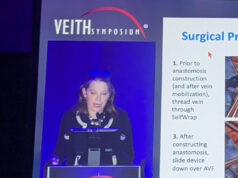This advertorial is sponsored by Vascular Therapies
 Arteriovenous fistula (AVF) maturation is a pivotal event in patients requiring haemodialysis. Maximising the number of fistulas that mature, become suitable for initial clinical use and remain suitable for sustained clinical use continues to be a high-priority objective in vascular access. To improve maturation success, an unmet medical need, Vascular Therapies is developing the sirolimus-eluting collagen implant SirogenTM, a single-dose prophylactic delivered intraoperatively at the time of the index AVF surgery. Sirogen will be tested in ACCESS 2, an upcoming phase 3 randomised clinical trial in high-risk patients.
Arteriovenous fistula (AVF) maturation is a pivotal event in patients requiring haemodialysis. Maximising the number of fistulas that mature, become suitable for initial clinical use and remain suitable for sustained clinical use continues to be a high-priority objective in vascular access. To improve maturation success, an unmet medical need, Vascular Therapies is developing the sirolimus-eluting collagen implant SirogenTM, a single-dose prophylactic delivered intraoperatively at the time of the index AVF surgery. Sirogen will be tested in ACCESS 2, an upcoming phase 3 randomised clinical trial in high-risk patients.
At the recently concluded Charing Cross Symposium (CX 2022; 26–28 April, London, UK), renal transplant and access surgeon Rajesh Sivaprakasam (Barts Health NHS Trust, London, UK) presented results from ACCESS—a multicentre, prospective, randomised controlled trial that enrolled 269 patients with end-stage kidney disease (ESKD) and chronic kidney disease (CKD) from 20 US sites. The study was designed to evaluate the safety and effectiveness of Sirogen to improve outcomes in patients undergoing surgical creation of an AVF for haemodialysis.
The trial did not meet its prespecified endpoints. Analysis of patient-level data showed that, despite randomisation, the treatment group had a significantly higher proportion of patients aged 65 years and older and those with coronary artery disease (CAD). Both variables are known risks for fistula maturation and this imbalance biased trial outcomes in favour of the controls.
To understand the impact of this imbalance, a post hoc analysis of the risk-differentiated data using an age cut-off of 65 years was performed. In high-risk ESKD patients, the Sirogen group showed a significant improvement in fistula maturation. This benefit was durable; at 12 months, a higher proportion of Sirogen-treated fistulas were functionally patent with freedom from abandonments (better secondary patency). To confirm these results, Vascular Therapies is initiating ACCESS 2, a randomised trial for high-risk ESKD patients.
Here, Sivaprakasam is joined by Vascular Therapies founder and chief scientific officer Sriram Iyer, and fellow renal transplant and access surgeon Surendra Shenoy (Washington University School of Medicine, St Louis, USA), in discussing Sirogen, and the ACCESS and ACCESS 2 studies.
Why sirolimus?

Iyer: Sirolimus (the active drug in Sirogen) has been proven to provide clinically beneficial anti-inflammatory and antiproliferative effects. Vascular injury, such as the trauma related to the surgical creation of a vascular anastomosis, stimulates the normally quiescent cells in the vascular wall to enter a proliferative phase marked by secretion of extracellular matrix, proteases, growth factors and cytokines, and migration to the intima. Although cell migration and proliferation are important and expected biological responses to vessel injury, this process is largely uncontrolled and unpredictable, and an excessive proliferative response results in neointimal hyperplasia, leading to a flow-limiting stenosis.
Sirolimus combines with the mechanistic target of rapamycin (mTOR) and suppresses cell proliferation. Clinical proof to support the antiproliferative action comes from the extensive experience of sirolimus-eluting coronary stents. In comparison to paclitaxel, a cytotoxic antiproliferative with a very narrow margin of safety (which, if breeched, can result in vascular necrosis), sirolimus is a cytostatic with a wide therapeutic window and negligible vascular toxicity.
Is there any risk of systemic immunosuppression?
Iyer: For therapeutic immunosuppression, an oral dose between 2–5mg per day of sirolimus is required to achieve and maintain a target whole-blood trough level of 15ng/ml (range 12–20ng/ml). In contrast, the one-time dose of sirolimus delivered perivascularly to the vessel wall from the Sirogen implant is a fraction of the oral dose and pharmacokinetic data show that a very small amount of the locally eluted sirolimus gains access to the circulation, resulting in systemic concentrations that are well below levels required for immunosuppression.
How does a drug delivered from outside the blood vessel reduce stenosis that is inside the vessel?
Iyer: Research using an animal arteriovenous graft (AVG) anastomosis model has shown that, soon after anastomosis is completed, adventitial fibroblasts begin to proliferate, acquire the phenotype of myofibroblasts (i.e. express smooth muscle cell actin), migrate through the media to the intima and are major contributors to the final neointimal tissue volume in the peri-anastomotic area. This explains how periadventitial application of Sirogen, a formulation that contains the antiproliferative sirolimus, has the potential to reduce the risk of an intravascular stenosis (‘outside-in’ approach).
What are the most interesting findings from your CX 2022 presentation of ACCESS?

Sivaprakasam: The ACCESS randomised trial confirms advancing age is a risk factor for AVF maturation as shown by other published studies. Local targeted drug delivery using the perivascular approach is feasible and there were no safety concerns. In the ≥65-year-old high-risk ESKD cohort, Sirogen use provided a strong efficacy signal for improving AVF maturation. The benefit appears to be therapeutically durable as evidenced by the better 12-month functional and secondary patency in comparison to the standard of care controls.
Since the high-risk subgroup analysis from ACCESS is post hoc, how do you know the results are not a false positive?
Sivaprakasam: As with any post hoc analysis, it is entirely possible that the results in the ≥65-year-old group are false positive; validation awaits the completion of the high-risk ACCESS 2 trial. However, optimism that these encouraging results will be confirmed is based on outcomes using Sirogen in other patient groups. To date, across three different cohorts, patients treated with Sirogen have outperformed historical benchmarks. These studies include:
- The maturation success of Sirogen-treated AVFs in the phase 2 AVF study (n=30)
- The open-label cohort from the phase 3 study (n=26)
- The outcomes in the high-risk randomised cohort of the ACCESS study
This consistency provides reassurance that the results are likely ‘real’, and not a one-off or false positive.
The ACCESS 2 study will only include patients aged 65 years and older—why is this?

Shenoy: ACCESS 2 is designed to be a high-risk trial, to help validate the results from the ACCESS study. Although advancing age is a risk for fistula non-maturation, this does not mean that patients younger than 65 years do not require treatment to help improve maturation of their AVFs. Approximately one in three AVFs in patients younger than 65 years have problems with maturation and fistula outcomes in younger patients also need improvement.
Why is enrolment in ACCESS 2 restricted to radiocephalic AVFs?
Shenoy: High-risk variables that influence fistula maturation include advancing age, female gender, African American ethnicity, comorbidities like diabetes mellitus, and presence of CAD and peripheral arterial disease. Because vessels in the forearm are smaller, maturation outcomes of radiocephalic fistulas are inferior to those in the upper arm. In the USA, over the last 25 years, maturation problems have led to a 50% reduction in the placement of forearm radiocephalic fistulas. Whereas, in the late 1990s, almost 70% of AVFs were radiocephalic, more recent data suggest that only about 35% of fistulas are created in the radiocephalic location. If the ACCESS 2 trial results confirm the maturation benefit for radiocephalic AVFs, it will be a clinically important outcome, because it will help increase the number of access sites for patients.
Are there other potential indications for Sirogen?
Shenoy: Testing the value of Sirogen delivered locally at the venous anastomosis of polytetrafluoroethylene (PTFE) AVGs is the next logical indication. A small phase 2 AVG feasibility study performed by Vascular Therapies showed a one-year primary patency rate of 76% for sirolimus-treated access grafts. Of course, these results now need to be reproduced in a larger patient cohort. Another possible indication includes improving the patency of below-knee bypass grafts in patients with critical limb-threatening ischaemia, because flow-limiting stenosis at the vascular anastomosis site is an important cause of graft occlusion and failure.













